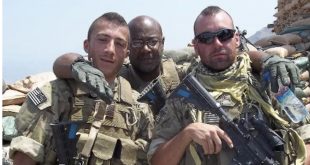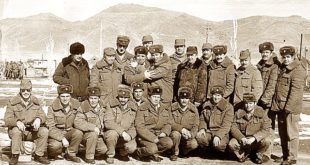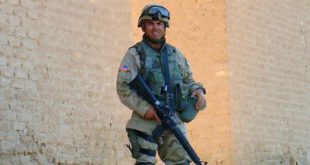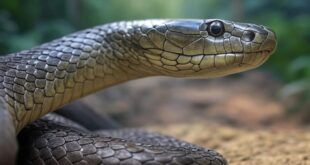HELL ON THE HO CHI MINH TRAIL: THE HUNT FOR AN EXTINCT COW

By Robert K. Brown and Vann Spencer From I Am Soldier of Fortune
Lurch, jolt, lurch, jolt. Riding elephants for 12 hours a day at three klicks an hour was proving to be a mind- and butt-numbing experience as Robert Mackenzie and I moved through the desolate, savanna-type Cambodian jungle. ant-covered bamboo slapped our faces in rhythm to the lurching gait of the elephants. Thank God and Gargoyle sunglasses we still had our eyes.
It was becoming another pointless, painful adventure. There had been a point to it all, but at this juncture, after hours on the back of an elephant, we found the purpose growing less and less noble.
Like most adventures, it initially sounded more intriguing and glamorous than it was turning out to be—like jumping from a perfectly good airplane, when, while shuffling to the door, the bile trying to claw its way up your throat, you ask yourself once again, “Why am I doing this?
it all started in the spring of 1993, when Nate Thayer, a young journalist whose career SOF helped launch a few years before, called the SOF office.
“Brown, how ya doin’? How’d you like to go on a scientific expedition . . . to locate a species of cow that was thought to be extinct for 50 years?” he was talking about a creature called the kouprey, native to Southeast Asia.

THE HUNT FOR AN EXTINCT COW
Well, we always thought cows were for eating or, if wild, e.g. cape buffalo, for shooting and then eating. a scientific expedition? ho hum.
Thayer, an American son of some diplomatic or upper crust family, was a daredevil, a handsome ladies man who had forsaken a normal lifestyle and gone native in Thailand. Ever resourceful, and some would say a certifiable mad hatter, he had been pushing the envelope for years. He’d had malaria 16 times, and kept a motorbike hidden on the Thailand-Cambodia border to periodically make unannounced drives into Khmer Rouge (KR) country. He also managed to get blown up when the truck he was riding in hit a land mine, killing ten of the other 12 passengers, and when he positioned himself to the right-rear of a recoilless rifle shooting Burmese from a Karen bunker, instead of a Pulitzer-winning photo he got a snap of the bunker ceiling and lost 95% hearing in one ear.
Vann and I had met Thayer in an ex-pat hangout in pat pong, the notorious red light district in Bangkok, a few years earlier. he was getting over some illness or other and was haggard and down and out. The fevered eyes enhanced his tall good looks. he had been risking his ass putt-putting on a motor bike into KR country, which was both stupid and foolhardy, so I put him on the SOF payroll for $400 a month. I was throwing the dice again, gambling on an unknown quantity. it wasn’t the first time and wouldn’t be the last.
he started turning in some good copy so i introduced him to one of the few AP journalists i respected, Denis Gray, the longtime AP bureau chief in Bangkok. Thayer, starting out as a freelancer, started selling more and more good copy to Gray and, was promoted by Gray to AP bureau chief in Phnom Penh, Cambodia, shortly before the ’93 elections. he had nobody to “chief ” as he was a one-man show, but he made his bones. be- cause of his connections with the KR (nobody ever figured out why they didn’t just shoot him when he showed up) he managed to orchestrate the surrender to the U.N. of some 400 Montagnard tribesmen from Vietnam who had been fighting the Vietnamese in the eastern part of Cambodia ever since the fall of South Vietnam in April 1975. The yards, their numbers depleted over the years because of continuous combat, had been fighting along with the KR for years. a classic case of the “enemy of my enemy is my friend”. he also played a part in getting the Montagnards resettled in the U.S.
A MADMAN ADVENTURER STRIKES GOLD
He later had an exclusive during the highly politicized trial of the genocidal murderer pol pot. pol pot, who was supported by the United States at first, ordered the slaughter of a million Cambodian s. a newscaster i won’t name stole the scoop. Thayer sued him and received a bundle.
Thayer must have sensed i was less than enthusiastic about his cow idea, so he started upping the ante.
“Brown, we’ll chopper into the base camp; use elephants to recon.” On an interest level of one to 10, that was at about a two.
“We’re going into KR country in eastern Cambodia, near the Vietnam- ese border, along the ho chi minh trail.” my interest level was now at five.
“We’ll all be carrying AKs and whatever else is necessary.” interest level six.
“Our tracker/scouts will be former FULRO [United Front for the Struggle of Oppressed Races] Montagnards who fought the NVA for 17 years after Saigon fell whom i helped resettled in the States,” he continued. “if we find that ‘extinct’ cow, we’ll all be famous!”
Thayer, a very seasoned wheeler-dealer sensed me wavering. He hesitated and then sank the harpoon of adventure deep in my psyche.
“And there are marauding tigers in the AO. We’ll need someone to deal with that threat. an AK, even on full auto, won’t do the job quickly enough. We need a big caliber gun and someone who knows how to use it.”
Bingo! Interest level 10.5. i was hooked but good. I had hunted dangerous game in Africa but never thought i would have a chance at a tiger. Now, as our elephantine convoy continued to lurch and jolt through the bamboo like a sailor on leave, we wished I had spit Thayer’s hook out.
After losing several thousand dollars’ worth of camera gear to thieves who work the pricey Sukhothai hotel in Bangkok, we arrived in Phnom Penh to be greeted by Tim page, a crazy British film shooter who made his bones big time as a combat photographer in Nam, and Thayer, whom we quickly labeled “colonel Kurtz.”
Thayer, speaking fluent Cambodian , bamboozled my stainless steel Ruger .375 H&K through customs, prattling about being a friend of the king; close friend of the prime minister, yada,yada. Whatever works.
In the capital, we were headquartered on the second floor of an old, mildewy French villa that served as an office for the only English-language daily, the Phnom Penh post. as we dumped our gear on floor, Thayer popped beers and said, “Welcome to the freest country in the world!”
Our puzzled glances prompted him to open a large cabinet containing an old French maT-49 submachine gun, a selective-fire Chinese m-14, several AKs, an m79 grenade launcher and cases of ammo. Obviously, no 4473s required here. as if to reinforce his assertion, Thayer rolled and lit up a joint, continuing: “anything you want. you can get a 50-kilo bale of pot at the market; there’s an opium den down the street and you can pick up a case of AIDS without much difficulty.” hmmm. One might define freedom that way; all in the light of what you’re smoking. The arsenal was intriguing, but we passed on the offer of dope and communicable disease.
Thayer’s prior planning primarily consisted of drinking, smoking and banging the local bimbos. Even though Tim page had assumed S-4 responsibility and acquired a fair amount of equipment, there would be consider- able delay. Food, weapons, communications and air transport were among “minor details” not resolved for our 25-man foray into the KR-controlled, tiger-infested jungle.
Over the next days we cleaned weapons, scrounged equipment in Phnom Penh markets and met other expedition members. an experienced Italian veterinarian and author of the definitive book on camels, Maurizio “Mo” Dioli, was the scientific member.
Mo, Phnom Penh post publisher Mike Hayes, his reporter and a Thai TV cameraman were ready to go. We awaited the four-man team of FULRO Montagnards with their American escort from Stateside.
We marked time visiting the battle zone at Pailin where the last remnants of the KR were battling for survival with the armed forces of the Cambodian government and aside from that just caught some rays. as we tanned, the plan evolved into final form. Alternative transportation had to be organized; the three Cambodian choppers Thayer had promised were not to be—turned out the Cambodian army only had three choppers. Scrounging had us at operational status by the time the Montagnards arrived. Master wheeler dealer Thayer had convinced Cambodia’s prime minister of the expedition’s merit, so we had use of his personal twin-engine turboprop.
A RENDEVOUS WITH ELEPHANTS
The first staging point was Sen Monoram in Mondol Kiri province, where the governor organized a truck for the next leg and provided a 12-man detachment of Cambodian para-military police because of Khmer Rouge in the area. The governor issued the Montagnards aK-47s to increase expedition firepower. The SOF team members brought their own. Next morning, our party with our supplies boarded a clapped-out truck and headed north on a dirt road. Most Cambodian roads boasted only dirt and pot- holes; this one ran more to potholes than dirt. The plan was to drive until we ran out of road, where we were to link up with elephants arranged by the provincial governor.
Of course, there were no elephants. By the time some they showed up, we’d lost another day. We hung out at the trailhead in hammocks, impressing local villagers. They were so enthralled that the headman invited us for rice wine (as third world vintages go it could have been worse, but not much) and a pitch for American aid, lest his village vanish. The chief had three wives and the village was knee deep in children and pregnant women, so vanishing didn’t seem imminent. at daybreak we continued north.
KOMINGTANG, ELEPHANTS AND FROGS; ALAS NO COW
all walked except the overweight American who escorted the Montagnards. by mid-afternoon it approached a stifling, heat-stroking 100 degrees. We had become separated into two groups, since elephants walk more slowly than men. The command element, English-speaking Montagnards and Thayer were two hours behind.
“There is a river a couple of hours out,” Thayer had promised. by 1400 there was still no river, so we stopped and waited for the “leaders.” When they appeared at 1600 the priority was water, so we moved west toward the nearest watercourse. an hour of bush bashing brought us to the blue line on their map, huge pools of water. Soon elephants were in one pool, Cambodian soldiers in another and the expedition was drawing water from a third. a third world car wash was underway in the elephant pool with much splashing and frolicking as the mahouts scrubbed their charges.
We reached the proposed base site the next day and pitched camp. The following day we split into two groups to search for the cow. both groups saw herds of banteng, another wild ox with which the legendary Kouprey
Often cohabits. One group also saw packs of wild dogs and wild boar but no cow, yet. The next morning as we were getting ready to leave our overnight site, Thayer’s walkie-talkie crackled with the words we didn’t want to hear. a sentry had spotted a Khmer Rouge soldier, who had also spotted him. The sentry returned to camp firmly convinced the soldier was not alone and that this did not bode well for our mission.
Despite Thayer’s assurance from the KR representative that the area commander was aware of and approved our mission, there was no certainty all local KR guerrillas had gotten the word. On return, we had a hurried conference to discuss options. We could continue stumbling through the bush seeking the Kouprey, we could try to talk to the KR and assess the situation, or we could haul ass back to Phnom Phen. The SOF contingent opted for the second choice since the KR surely knew we were there and showed no hostile intent. Prevailing sentiment, however, was that no one wanted to get killed looking for a cow, so everyone upped sticks and re- turned to base camp. The KR’s reputation for ferocity and unpredictability was enough to tip the scales in favor of withdrawal. Things were not going well back at camp, however. Suffering from the heat, page, a real prissy, sniveling Brit whined, “i am dying here. Please get me a helicopter medevac.”
Right. On the Ho chi min Trail! News of KR in the area corroborated his premonition of bad things happening and reinforced his demand to go home. The American Montagnards’ adviser was also down with heat and excess poundage—another candidate for medevac. With no radios to call the non-existent helicopter, we sent them out by elephant the next day. The TV cameraman, with several hours of footage already, and the post reporter with a deadline, also returned with three of the elephants and four of the Cambodian s.
The remaining crew spent the next several days looking for Kouprey in an area clearly devoid of any animal life (but far from the KR), as there was neither hoof print nor cow pie anywhere in the barren landscape. how- ever, as we could not convince the semi-intrepid Montagnards’ leader to go back to where we had seen herds of cows and the lone rifleman, we ended the futile search and returned to base. We broke camp in the evening in order to get an early start back to Sen Monoram.
Late that night, the dry season ended and in the next hour more than
three inches of rain inundated our campsite, which was devoid of tarps. Amid curses and mutterings around the camp, our hammocks took on water at a slow but constant rate and did not let it out. The noise of the storm faded, replaced by a din such as we had never heard during many campaigns on many continents: The first monsoon rain was reveille to all the frogs in Cambodia, who had been waiting underground for it for months. Hundreds of thousands of frog voices in varying tones, timbres, pitches and strengths joined in a vast jungle cacophony loud enough to elicit empathetic vibrations in the intrepid expeditionaries’ chest cavities. It was an incredible, surreal experience—National Geographic should have been there to record it.
Musing on the phenomenon, Mackenzie tipped more water from his hammock and wrapped himself in a sodden but still effective poncho liner, finally drifting off into a broken sleep in order to dream of giant frogs. Finally, back in Phnom Penh, Thayer gave Mackenzie and me a gracious invitation: “Let’s do this again soon,”
“Go to hell! Once was once too much.”
Just before 9-11, Vann and i met up with Thayer in Washington D.C. he had not changed. by then he had gained fame with his interview of dictator pol pot and was a sought-out journalist. he was restless, completely out of place in the city of pompous suits, and just waiting for the next adventure that could provide adrenalin rushes and a lawless free- wheeling, devil-may-care lifestyle. 9-11 and the invasion of Iraq provided the opportunity.

 Soldier of Fortune Magazine The Journal of Professional Adventurers
Soldier of Fortune Magazine The Journal of Professional Adventurers





